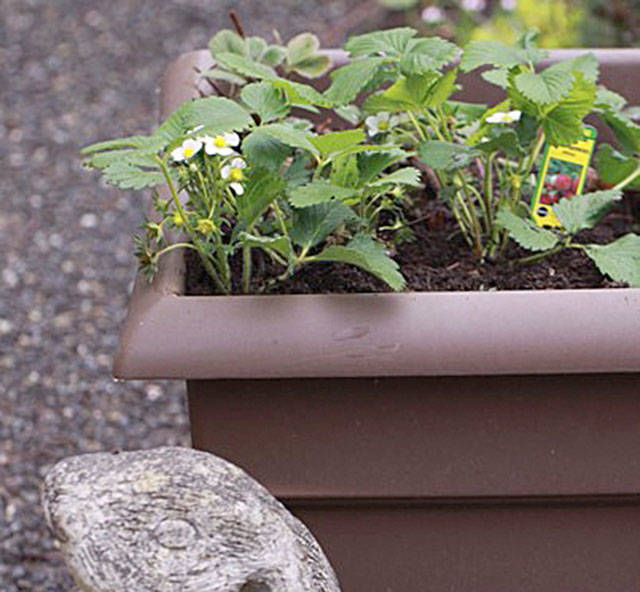Good berry varieties for growing in containers
Strawberries
Seascape
Tribute
Tristar
Raspberries
Raspberry Shortcake
Blackberries
Baby Cakes
Blueberries
Blueberry Glaze
Chippewa
Jelly Bean
Northblue
Northcountry
Northland
Northsky
Peach Sorbet
Pink Icing
Polaris
Sunshine Blue
Top Hat
Get involved
The “Saturday in the Garden” series begins May 19. This presentation will be held at the Woodcock Demonstration Garden in Sequim. From 10-11 a.m., nutrition coordinator Karlena Brailey will discuss “Home Gardeners Helping to Fight Hunger in Our Community.” The classroom area is outdoors; there is a roof, but dress warmly.
The Port Angeles Plant clinic and One-on-one Garden Advice continue on Monday, May 21. The Master Gardeners will be available at the Clallam County Courthouse and the Fifth Street Community Garden that morning. Please come with your gardening questions and concerns.
Although berry plants are most productive when planted in the ground, there are many good reasons to grow them in containers.
You might grow berries in pots because your garden space is limited or the soil in your garden is not right for growing berries (for instance, not acidic enough for blueberries).
Growing berries in containers close to your house can give you easier access to tend and harvest them and the proximity to humans might deter a few four-legged pests.
Finally, berries (and often the plants they grow on) are attractive and eye-catching. Growing them on your front porch, deck or patio can add ornamental value to your home and surroundings.
Although many berries can be grown successfully in containers, it is best to select varieties that are smaller and more compact (see box).
• Day neutral strawberries produce fewer runners than June-bearing strawberries, making them more adaptable to containers. They also produce strawberries throughout the growing season.
• Half-high and dwarf blueberries top out at 3-4 feet and are a better choice for containers than northern highbush blueberries that easily can achieve 6 feet in height.
• Newly released dwarf raspberries and blackberries have a compact growth habit, reaching only 2 to 4 feet in height. The added bonus is that they tend to be thornless.
Plant your berries in containers large enough to accommodate the roots and transplant to larger containers, as needed. Even the smaller, compact varieties will do best when planted in 24- to 36-inch diameter containers. If you choose to grow full-sized varieties such as Northern highbush blueberries you will need to grow the plants in half wine barrels.
Make sure your container has drainage holes since berries don’t like wet feet. Use high quality potting soil as opposed to garden soil because it drains better and has been treated so as not to carry diseases or pests. For blueberries, use a soil made for acid-loving plants.
Locate your containers in full sun. Although most berries tolerate a little shade, they produce best with 6 or more hours of sun a day. If sun exposure is not good close to your house, consider putting the containers on a wagon or cart and “following the sun,” moving them from sunny spot to sunny spot throughout the day.
Water your plants so that the soil remains moist but not soggy. Because soil in pots usually dries out faster than in the ground, check your pots frequently. During dry periods you might need to water daily.
In general, berries are not heavy feeders but frequent watering can leach nitrogen from the soil. For strawberries, raspberries and blackberries apply a balanced fertilizer (with equal amounts of nitrogen, phosphorus and potassium) in early and late spring. Blueberries prefer a fertilizer that provides nitrogen in the form of ammonium such as ammonium sulfate.
Although the smaller varieties recommended for container planting might not require staking or trellising, your container grown berries will need pruning similar to their full-sized counterparts. For example, second year canes need to be pruned on all raspberries and blackberries after the harvest and all blueberries need removal of older, non-producing canes to encourage the production of new canes.
Finally, plants in containers are at a greater risk of cold injury than plants in the ground because the roots are more exposed. In winter, move your container to an unheated garage or wrap the pot with bubble wrap or newspaper to protect the roots.
Growing berries in containers is both fun and rewarding. With the right variety and a little forethought, you’ll soon be picking plump, juicy berries from right outside your door!
Jeanette Stehr-Green is a WSU-certified Clallam County Master Gardener.



